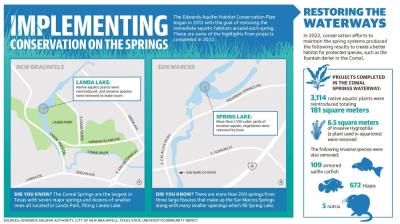The Comal and San Marcos springs are major focal points of those efforts, according to local conservationists, and key indicators of the overall health of the aquifer system.
The EAHCP—or habitat conservation plan—is a cooperative effort bringing together multiple city, state and federal stakeholders to protect groundwater resources of the southern portion of the Edwards Aquifer, both for people in the region and the endangered species that inhabit the aquifer. The habitat conservation plan began in 2013 and runs through 2028, though the renewal permitting process has begun, according to the Edwards Aquifer Authority.
During periods of low water flow and significant drought events—such as the ongoing drought—efforts to remove invasive plants and animals from the waterways are ramped up to help in the survival of 11 protected species in those waterways, said Kristy Kollaus, a biologist and environmental scientist with the EAA.
“For each particular species, we have certain habitat measures, either mitigation or improvement. So particularly if we’re going to look at the fountain darter—which is found within both systems [the Comal and San Marcos springs]—you see a lot of people out there [making] efforts to remove nonnative aquatic vegetation and replant with native aquatic vegetation,” Kollaus said. These efforts should improve habitat for the fountain darter to have a more robust population even during low flow periods, Kollaus said. Aquatic vegetation restoration, the removal of invasive aquatic vegetation, the removal and control of nonnative fish species, litter removal and water quality protection are some of the measures that go into the habitat conservation plan to ensure each unique ecosystem remains clean and useful.
Maintaining the waterways
For 2022, the EAA reported significant native aquatic vegetation restoration and invasive vegetation removal from both the Comal and San Marcos springs waterways.
Thousands of native aquatic plants were reintroduced to the old channel, Landa Lake and Comal River in New Braunfels, increasing the natural habitat of the springs for the endangered species. Similar efforts were made in the Old Channel Restoration Reach.
In addition to those restorative efforts, nonnative Hygrophila—an invasive species that chokes native wildlife—was removed from the Comal River system. Armored sailfin catfish, tilapia and nutria were also removed.
Nutria—the beaver-like large rodents that are native to South America and found along both waterways—are particularly important to remove from the ecosystem, said Phillip Quast, watershed coordinator for the city of New Braunfels. “The nutria actually damage the habitat directly for the endangered species,” Quast said.
As conservation efforts continue, those involved in the work are able to point to specific benchmarks that indicate what their next steps are in preservation, such as the reintroduction of native Texas wild rice that is choked out by invasive plants.
“We have already hit our goal for Texas wild rice expansion and pretty much every targeted section of river,” said Christopher Riggins, a research biologist and lead of the Meadows Center’s Habitat Field Crew at Texas State University. “We’re also about to reach our next goal [for 2024], which is the reduction of invasive species where it’s basically all bulk removal. Major patches and sections in the river have all been removed. So [we’re] just having to learn how to maintain that effort.”
Tackling use and protection
There are five governing entities—or groundwater pumping permittees—to protect the groundwater resources of the Edwards Aquifer and its endangered species that inhabit it. The EAA; the cities of New Braunfels, San Marcos and San Antonio—acting by and through the San Antonio Water System; and Texas State University work collaboratively to enact the plan and partially fund it.
Kollaus said those permittees on the habitat conservation plan have an overlaying goal of helping to provide optimal spring flow through conservation and irrigation abatement efforts to provide a habitat for the survival of the species, as well as insure the river systems remain adequate for recreation.All of the participating entities all somehow use the spring systems or the aquifer through pumping, so to counter what is taken away from the spring systems, each must participate in the conservation efforts. “So that’s kind of like the whole justification of why we have this [plan],” Kollaus said.
The governing entities are also entered into an aquifer storage and recovery spring flow protection program, whereby a certain amount of water from the aquifer is reserved and stored away until the annual recharge of the aquifer averages above a 500,000 acre-feet threshold, according to the EAA.






